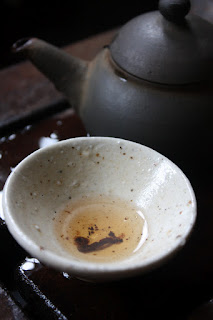The weather dropped to more of autumn temperatures this week. The response was drinking a few different pots of aged puerh. Found a sample of 1999 Chen Guang-He Tang YiWu Long Ma and brewed it up. A few weeks ago there was a review of this tea on Jakub's T blog where he pointed out that samples are still available from Houde. With something lingering on Houde for years at the same price one doesn't expect a mind-blowing puerh tea but just a pot that will chase away the cold. Let's boil the water and see what this tea has in store...
The dry leaves smell of faint, distant autumn leaves and cherry wood. They are placed in the warmed pot.
The first infusion offers a creamy, cherry wood taste that is fairly monotone with a flat sweetness. The mouthfeel is chalky in the mouth. There is a very subtle strawberry finish.
The second infusion delivers slight, sour-woody cherry wood notes with a slight finish of creamy-wood. Overall the tastes run through quite smoothly and without too much fuss. It has an almost unnoticeable strawberry-wood aftertaste which emerges minutes later.
The third infusion has that same initial taste with a interesting floral aftertaste now. It develops a soft, chalky mouthfeel.
In the fourth and fifth infusions the floral taste has even moved into the initial taste profile with a woody, slightly floral, creamy initial taste which skirts across the taste profile with a certain simplicity. The mouthfeel is soft, smooth, slippery, and chalky and is primarily kept to the tongue.
The taste of this tea is simple but has some interesting edges. In the sixth infusion there is a simple, subtle surgery-cinnamon aftertaste that arrives minutes after swallowing. In the seventh a woody-chicory-cherry wood taste starts to dominate with weak florals lingering in the aftertaste.
The eighth infusion delivers a simple woody taste with long lingering but faint sweet vague fruit aftertastes. The mouthfeel remains mainly on the tongue. A cooling sensation is left in front of the mouth and tongue. The qi of this tea is very mild and pleasantly relaxing with a diffuse, weak warming energy.
The next handful of infusions don't change that much from the eighth infusion except they become a touch drier in the mouth. Later the tea is put into a series of overnight infusions which yield deep-prune and high cherry-plum fruit tastes- a nice balance.































